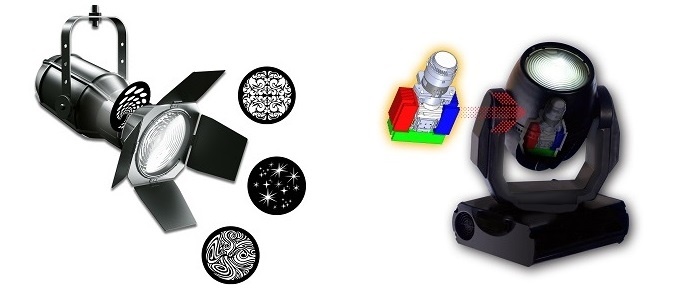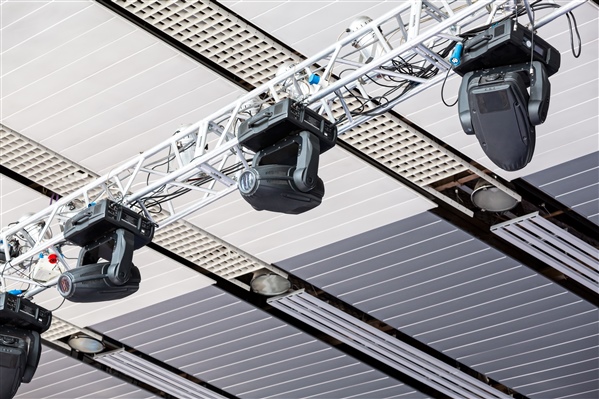-
DLP Technology Is Set to Light up Stages Worldwide
DLP Technology Is Set to Light up Stages Worldwide
Raecine Meza
DLP technology is taking center stage. Literally.
A new optical reference design from TI demonstrates that stage lights using DLP technology are comparable with traditional spotlights in terms of the brightness using just a single DLP chipset to deliver up to 15 kL of monochrome light to the stage. After brightness, systems leveraging DLP technology surpass existing designs by offering programmability, versatility, reliability and scalability - all while reducing operating costs.
Traditional spotlights cast shapes and patterns by projecting the light through metal or glass cut-outs, known as a ‘GOBO,’ from ‘goes before the optics’. Every time a different pattern or shape is needed, the GOBO must be changed either manually or with motors. DLP technology enables digitally programmable stage lights to display innumerable shapes, patterns and even video effects. DLP technology can change the projected light pattern instantaneously, without the delay of an electrical motor. With DLP technology, there are no GOBO motors to maintain, which can lower your costs over time.
 Figure 1 Traditional lighting system
using a GOBO and a stage lighting system using DLP technology
Figure 1 Traditional lighting system
using a GOBO and a stage lighting system using DLP technologyA stage lighting system leveraging DLP projection capabilities will consist of a digital micromirror device (DMD), digital controller chip, and any ancillary chips such as power supply devices along with illumination and projection optics. The optical reference design demonstrates an architecture that is a scalable to using multiple light sources and is compatible with incandescent lamps, LEDs and lasers.
For a performance or concert requiring monochromatic white light, a spotlight with DLP technology can scale upwards to 15,000 lumens. Full-color stage lighting systems can project up to 10,000 lumens.
 Figure 2 Scenario Showcasing DLP
Technology Stage Lighting System
Figure 2 Scenario Showcasing DLP
Technology Stage Lighting SystemMore advanced spotlights using DLP technology can be complementary to traditional stage lighting methods. For example, mechanical GOBOs can be employed in conjunction with a monochromatic digital light. In this type of application, translucent colored GOBOs could function as the color management subsystem for a white monochrome, fully programmable stage light system. The appropriate colored GOBO filter could be switched in and out as needed by the application. See more ways TI is playing in the stage lighting space on the Industrial Strength blog.
To learn more about how DLP technology is expanding the design space for stage lighting effects, visit our lighting overview page. Visit the DLP Products E2E community to request more information about the optical reference design.
Additional Resources:
- Read the whitepaper Using DLP technology for stage-lighting systems.
- Learn more on the blog post: Color the world with what's next in RGBW LED light source technology.
IMPORTANT NOTICE AND DISCLAIMER
TI PROVIDES TECHNICAL AND RELIABILITY DATA (INCLUDING DATASHEETS), DESIGN RESOURCES (INCLUDING REFERENCE DESIGNS), APPLICATION OR OTHER DESIGN ADVICE, WEB TOOLS, SAFETY INFORMATION, AND OTHER RESOURCES “AS IS” AND WITH ALL FAULTS, AND DISCLAIMS ALL WARRANTIES, EXPRESS AND IMPLIED, INCLUDING WITHOUT LIMITATION ANY IMPLIED WARRANTIES OF MERCHANTABILITY, FITNESS FOR A PARTICULAR PURPOSE OR NON-INFRINGEMENT OF THIRD PARTY INTELLECTUAL PROPERTY RIGHTS.
These resources are intended for skilled developers designing with TI products. You are solely responsible for (1) selecting the appropriate TI products for your application, (2) designing, validating and testing your application, and (3) ensuring your application meets applicable standards, and any other safety, security, or other requirements. These resources are subject to change without notice. TI grants you permission to use these resources only for development of an application that uses the TI products described in the resource. Other reproduction and display of these resources is prohibited. No license is granted to any other TI intellectual property right or to any third party intellectual property right. TI disclaims responsibility for, and you will fully indemnify TI and its representatives against, any claims, damages, costs, losses, and liabilities arising out of your use of these resources.
TI’s products are provided subject to TI’s Terms of Sale (www.ti.com/legal/termsofsale.html) or other applicable terms available either on ti.com or provided in conjunction with such TI products. TI’s provision of these resources does not expand or otherwise alter TI’s applicable warranties or warranty disclaimers for TI products.
Mailing Address: Texas Instruments, Post Office Box 655303, Dallas, Texas 75265
Copyright © 2023, Texas Instruments Incorporated